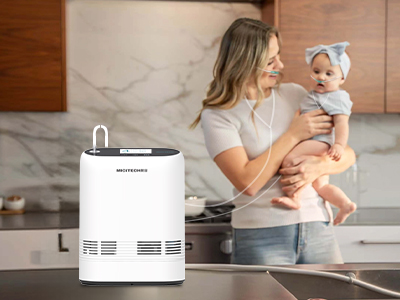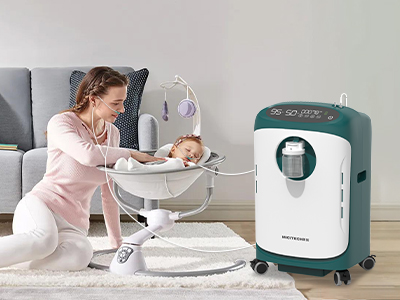06 Jun 2025
If you’ve been walking the rocky road of Oxygen therapy for your child, you’ve likely wondered at some point, “When is the right time to unplug the oxygen machine and let them breathe freely?” While it would be super convenient if there was a big, glowing "EXIT" sign above the oxygen tank, the truth is a little more nuanced. Oxygen therapy is like a superhero sidekick to your child’s lungs, offering essential support, but there comes a time when that sidekick needs to retire (well, at least for the day-to-day stuff). The question is: how do you know when it’s time to say goodbye to the oxygen mask? Buckle up; we’re diving into the journey of when (and how) your child can stop oxygen therapy.

What is Oxygen Therapy Anyway?
Oxygen therapy is like sending in the cavalry for your child's respiratory system. It’s when doctors give supplemental oxygen to help children whose lungs need a little extra hand to get oxygen into their bloodstream. Whether due to a chronic lung condition, premature birth, or a temporary illness like pneumonia, oxygen therapy helps maintain healthy oxygen levels when their lungs are throwing in the towel.
Think of it like a backup battery for your child’s lungs – always there when needed. It can come through nasal cannulas (those tiny tubes up the nose), face masks, or in more extreme cases, tents or machines. And while it’s crucial for giving your child a boost, the goal is always to wean off when the body can handle the job on its own. The million-dollar question is: when does that magic moment happen?
The Factors That Influence the "When"
If there was a simple, one-size-fits-all answer, this would be an easy read, but alas, we live in the complex world of pediatric health. Stopping oxygen therapy depends on several factors. Let’s break it down.
How’s Your Kid’s Oxygen Level? The first big player here is your child’s oxygen saturation level. This is how much oxygen is in their blood. Doctors keep a close eye on this using a pulse oximeter – a fancy device that clips onto the finger like a tiny sock thief (but way more beneficial). If their oxygen levels are stable and stay above 90% without extra help, it's a good sign that they’re on the right track.
Is the Underlying Condition Improved? Did your child’s lungs just need a little TLC because of something temporary, like pneumonia? Once the illness clears up and their lung function rebounds, that oxygen mask might just be ready for the shelf. But if there’s an underlying chronic condition, like asthma or cystic fibrosis, this could complicate things, and oxygen therapy may need to be ongoing.
Age and Development: Babies born prematurely are prime candidates for oxygen therapy because their lungs might not have finished developing. As they grow and their lungs mature, they may gradually be able to breathe unaided. But don’t expect to remove that oxygen tube just yet – it takes time.
How Strong is the Child’s Breathing? A kid who’s able to keep up with their friends in a game of tag without gasping for air? That’s a solid indication that their lungs are getting stronger. If your child’s breathing becomes regular and less labored, you might be seeing that light at the end of the oxygen tunnel.
The Magical Weaning Process
The idea of weaning your child off oxygen is a bit like trying to take away their favorite blankie – it requires patience, careful observation, and a gradual approach. The key here is not to go cold turkey. A sudden removal of oxygen could be like pulling the plug on your child’s life support, which, spoiler alert, is a terrible idea.
Typically, the weaning process involves reducing the amount of supplemental oxygen over time. Doctors will monitor your child closely, adjusting the flow of oxygen based on how well they’re doing without it. It’s a slow process – after all, lungs aren’t like light switches. They don’t just flick from “on” to “off.” It’s more of a dimmer switch situation, where the oxygen flow is gradually reduced until your child can maintain healthy oxygen levels independently.
While this process might take weeks or even months, the end goal is to make sure that their lungs have fully adjusted and are ready for a world without supplemental oxygen.
Signs That Your Child’s Ready to Ditch the Oxygen
So, how do you know when your child’s ready to leave the oxygen behind? You’ll be looking for a few telltale signs that indicate their lungs are up to the challenge.
Steady Oxygen Levels: If your child’s oxygen saturation stays comfortably above 90% without any assistance, that’s a great sign. If they’ve been maintaining healthy oxygen levels over time, the time for weaning might be near.
Less Reliance on Oxygen: If your child is breathing well on their own during naps or overnight, that’s another good sign. When your little one isn’t in a constant state of dependency on their oxygen device, you’re likely heading in the right direction.
More Physical Activity: If your child is up and moving, playing around like the energetic tornado they are, and doesn’t seem winded or short of breath, it’s another clue. Oxygen is meant to help with day-to-day breathing, so if they can go without it, that’s a victory.
Clear Breathing: No more wheezing? No more shallow breaths? If their breathing patterns have become more regular and normal for their age, you’re getting closer to taking that mask off for good.

The Risks of Stopping Too Soon
Ah, the peril of getting too eager. While it’s tempting to yank off the oxygen and throw a "We Did It!" party, taking your child off too early could cause a world of trouble. If the lungs aren’t ready to function without the oxygen support, there’s a risk that the oxygen saturation levels could dip too low, leading to hypoxia. And that, my friend, is a serious problem.
So while it's great to feel hopeful about your child’s progress, don’t rush the process. It’s a balancing act. Too soon, and you risk causing harm. Too late, and they’re stuck with that annoying cannula for a bit longer. It’s all about finding the sweet spot.
What Happens After the Oxygen Mask is Gone?
Once the oxygen mask is off for good, there’s still a lot of checking in to do. Think of it like passing your kid off to a new phase in life, but with a few checkpoints along the way. Your doctor will likely schedule follow-up appointments to make sure your child is doing well without the extra oxygen boost. This is the part where they take their first deep breath of independence – and so do you.
During this phase, make sure you stay vigilant. If your child starts showing signs of fatigue, shortness of breath, or anything out of the ordinary, don’t ignore it. Early intervention is the name of the game.
Conclusion
Figuring out when your child can stop oxygen therapy is not a "one-size-fits-all" situation, but rather a step-by-step, thoughtful process that involves careful observation, expert medical guidance, and a lot of patience. It’s not about a magical day where you rip off the mask and call it a victory – it’s about gradual progress, knowing when your child’s lungs are strong enough, and making sure the transition is safe. So hang in there. With the right support and a little time, you’ll know when it’s time for your child to take that first big breath – on their own.
Keywords: oxygen therapy
Originally published 06 Jun 2025, updated 06 Jun 2025.